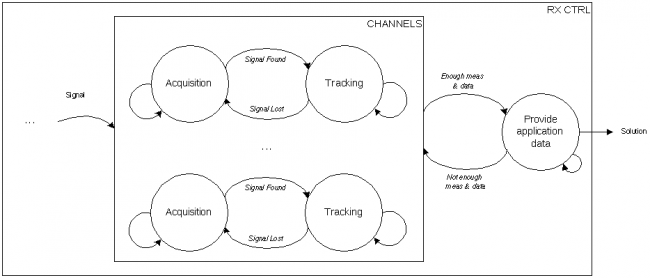If you wish to contribute or participate in the discussions about articles you are invited to contact the Editor
Receiver Operations
| Receivers | |
|---|---|
| Title | Receiver Operations |
| Author(s) | GMV |
| Level | Medium |
| Year of Publication | 2011 |
In the first years of GNSS, when only GPS was available for public use, a receiver was not expected to perform as the navigation devices we see today. In fact, a first-generation GPS receiver could be designed to only process 4 or 5 signals at any given time, and it was deemed suitable for positioning applications. Today, with the increased availability and potencial of different GNSS signals and constellations, any receiver is expected to track at least 10 or 12 signals in parallel channels, and up to hundreds, resulting in a more accurate solution. However, at their core - and despite the many differences in target applications or implementation philosophy - most receivers still share common control and processing flow management properties, resulting in common operations performed. The following sections describe these common operation modes in whitch a receiver functions.
Background
A GNSS receiver main objective is to determine its distance to a set of visible satellites, by tracking their transmitted signals. These signals have and underlying periodic code modulation that is precisely time-tagged by each satellite. Since the satellite time reference is very accurate and the same for all satellites, a receiver can determine the time it took for each signal to arrive, thus determining its relative position to each satellite. This process translates into a pseudorange measurement, which is a rough estimate of the user-satellite distance (not compensated for signal transmission delays and clock offsets).
Besides the pseudorange, other measurements are extracted in successful tracking operations: the carrier phase, defined as the phase difference between the received and the internally generated carrier (codeless), is a measurement of the cycle turns (accumulated wavelengths) tracked by the receiver. This observation is very precise, but ambiguous, since the total number of integer wave cycles from transmission to reception is unknown. Also, the Doppler frequency seen by the receiver, caused by the dynamics of the satellite-user system, represents the difference between received and internally generated signals, and is a good representation of the relative velocity between satellite and receiver.
As a result, GNSS receivers operate in a way that these observables are continuosly determined and refined in order to track the satellites, demodulate the navigation message and data, and compute the desired solution as accurately as possible.
Operations
One thing most GNSS receivers have in common is how they operate in terms of processing chain, from reception of signals to solution outputs. Alhough their types, architectures, and applications may vary, the operations (ilustrated in Figure 1 from top left to bottom right) apply transversly:
- Once the receiver is turned on, there is a start-up sequence needed to ensure that each channel is managed depending on the current operation status, and resources are allocated as needed. Before a receiver starts processing the samples from the RF stage, this initial operation mode sets up the necessary data and processes to ensure the best performance possible, also depending on the available a priori information (e.g. previous almanac or ephemeris information).
- As start-up and configuration is concluded, the antenna and the front end blocks start providing digitized data continuously to the signal processing channels. The input data can be in the form of real IF samples, or baseband (real and complex representation of the signal in I and Q components).
- Upon initialization, the channel is said to be in acquisition mode, where little or no information on the parameters (code delay and Doppler frequency) of the signal being tracked are known.
- The baseband processing block includes several channels dedicated to each signal being tracked. As mentioned in XXX, the objective of each channel is to perform a bi-dimensional search of code delay and Doppler frequency for each signal.The state diagram for each of these channels is depicted in the following figure.
- Signal processing: from signal capture at the antenna up to successfull tracking and data demodulation, different processing tasks are performed for each receiver channel in baseband processing. Examples are the correlation operations or the tracking loops.
- Acquisition: the first step, in many cases, is the search for visible satellites that can be tracked and used in the computed solution. Acquisition of visible signals is based on serial or parallel searches of the different possibilities.
- Tracking: after the initial determination of the satellites to track, several signal processing algorithms and loops are use to continuously track the satellite's motion relative to the user.
- Lock detection: a receiver constantly performes decisions to assess the quality of the observables in terms of noise or uncertainty, and these decisions determine the probability of a given tracked signal being "lost". This decision can yield a loss of lock, and the receiver channel is free to process other signals (e.g. start acquisition for other satellites).
- Navigation solution computation: with the observables from signal processing stages, together with almanac and ephemeris from the data messages, the receiver periodically computes the different outputs, such as the PVT solution.
- Navigation message demodulation: a receiver constantly performes decisions to assess the quality of the observables in terms of noise or uncertainty, and these decisions determine the probability of a given tracked signal being "lost". This decision can yield a loss of lock, and the receiver channel is free to process other signals (e.g. start acquisition for other satellites).
- Applications processing: when tracking is successfull for a large enough period of time, and for enough satellites, the navigation message can be decoded from each signal, and the extracted information is used to compute the best solution needed - in most cases, the user's PVT solution.
Related articles
For further details on GNSS receivers, please visit the following links:

